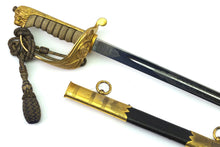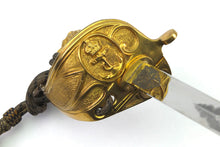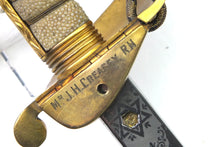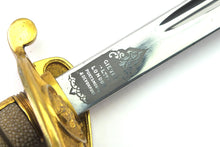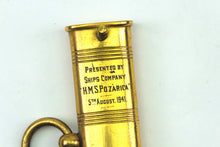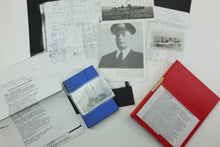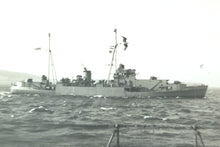
An 1827 Pattern Royal Naval Presentation Sword.
Missed out on this item? Click to view all current Antique Swords & Edged Weapons Free UK delivery on all items.
38" overall, 32" narrow blade with single fuller with crowned fouled anchor to one side & George VI cipher to the other. Proof mark to the forte one side & 'Gieves Ltd London, Portsmouth & Devonport’ to the other. Gilt brass shell guard with crowned anchor, fold down guard engraved ‘Mr J.H. Creasey R.N.’ with white fish skin grip & triple strand gilt wire with original sword knot. Gilt mounted black leather scabbard engraved on top mount ‘Presented By Ships Company H.M.S. Pozarica 5th August 1941’. Sold with various research, photos & a copy of ‘PQ17’ by Godfrey Winn.
Dated 1941
Sword in very good condition with all blade polish.
HMS Pozarica was a Merchant Ship commandeered by the Royal Navy then converted to an Anti-aircraft Cruiser. One of the few survivors of the infamous PQ 17 Convoy in July 1942 HMS Pozarica was herself sunk off Algiers on convoy duty after attacks by German and Italian Dive Bombers; surviving the action it was some days later that the ship went down suddenly on the 13th February
On the 27th of July 1942 convoy PQ-17 departed Iceland for the Soviet Union. Out of 34 merchant ships, only 11 would make it to port. At first, things seemed to be going well for the convoy as they beat off multiple German air attacks with relative ease. But on the 4th of July, everything went wrong. An order arrived from Admiral Sir Dudley Pound, the First Sea Lord himself reading 'Convoy is to scatter'. Fearing an imminent attack from German surface ships like Tirpitz the escort ships fled west while the merchant ships made for the Soviet Union.
But the Tirpitz was nowhere near the convoy, in fact, it was still at its moorings in northern Norway. Instead of saving the convoy from disaster, Admiral Pound's order had doomed PQ-17 to destruction. Over the following week, two thirds of the convoy were sunk by German aircraft and U-Boats. It was the biggest loss to a British convoy of the Second World War.
J.H.Creasey served in the Royal Navy from 1910, firstly as a boy then through both wars to attain a Commissioned Rank of Gunner Officer.












